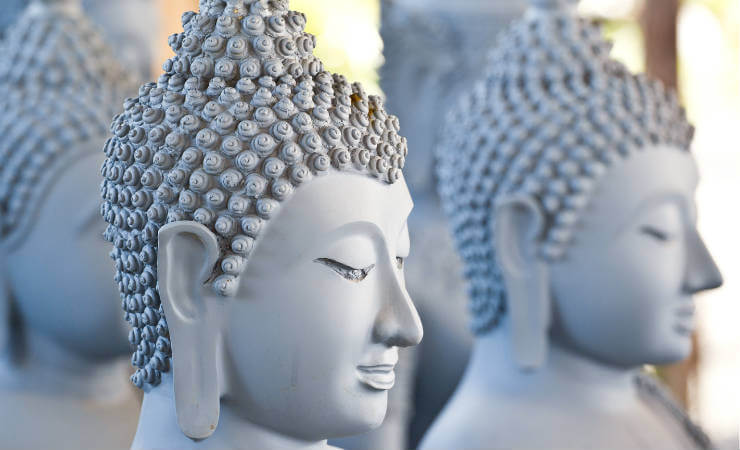Living the Eightfold Path
You may have heard of The Four Noble Truths of Buddhism. It is actually the Fourth Truth that contains The Noble Eightfold Path.
Briefly, the Four Noble Truths are:
1) The Truth of suffering or dukkha (there is suffering in life)
2) The Truth of the cause of suffering (craving, desire, ignorance)
3) The Truth of the end of Suffering (there is an end to suffering)
4) The Truth of the Path that leads to the end of suffering (The Noble Eightfold Path)
The presentation is simple and pragmatic. First is the observation that there is suffering in the world. Next, the Buddha then identifies the fact that our suffering is the result of attachment, desire, and ignorance. He then encourages us that there is a way out of suffering, which he outlines for us in The Eightfold Path.
The Path is a way of being, acting, and thinking in the world that will release us from suffering. It can almost be thought of as a moral compass, guiding us to the right way to act in the world.
Buddhism shows us how to live in the world. It is in theory very simple, but in practice it often brings challenges. That is why The Path is something that we practice every day.
It is practiced in order to understand the true nature of reality and to rid us of greed, hatred, and the like.
All eight parts of The Path can be practiced simultaneously, meaning you don’t have to follow one by one. Each part is linked together and each one helps cultivate the others. It is often the case, however, that some of the parts will take more practice than others.

Here is The Noble Eightfold Path:
1. Right View (Understanding)
2. Right Intention (Thought)
3. Right Speech
4. Right Action
5. Right Livelihood
6. Right Effort
7. Right Mindfulness
8. Right Concentration
The path is often divided into 3 sections.
1. Wisdom (Discernment): will help us understand reality and see the world as it really is. Right View and Right Intention are part of this section.
2. Ethical Conduct: will help us attain mental purification and virtue. Right speech, Right action and Right livelihood are part of this section.
3. Mental Discipline (Concentration): will help in developing true wisdom. Right effort, right mindfulness and right concentration are part of this section.
Let’s look at each part of the path so we can better understand what the Buddha was saying.
1. Right View
The first precept on The Path is Right View or Right Understanding. Here we see the world and ourselves without delusion. The reason we suffer is because of our clinging to things and having unrealistic expectations.
To help understand the world and our unenlightened experience in it, we need to understand the Three Marks of Existence.
The Three Marks of Existence are characteristics of the world and our existence that are factual and cannot be changed.
The Three Marks of Existence are:
1. Impermanence (anicca)
2. Insubstantiality or not-self (anatta)
3. Frustration or suffering (dukkha)
Impermanence relates to the idea that everything changes (except enlightenment or nirvana). Our bodies change, our minds change, or emotions change, situations change – everything changes.
Intellectually, this is pretty easy to accept, but it can be much harder to accept when we have to deal with the reality of an unwanted change.
Realities such as death or divorce or loss of material possessions are hard to truly accept. Even good feelings, emotions, and experiences will fade and change.
Wisdom requires a genuine understanding of the impermanence of all things – this wisdom is necessary for enlightenment.
The trouble is most of us cling to things as if they were permanent (a life, a relationship, a situation, etc.) and we find ourselves distraught when they come to an end. When we truly understand and accept impermanence, we will let go of expectations and clinging.
This is not to say that we will never or should never be sad. We are human; the Buddha was human. The point is if we truly understand reality, our sadness will not be the same and we will continue living each moment joyfully.
The 2nd Mark of Existence is Insubstantiality or not-self. This is related to the 1st Mark except that it looks strictly at the individual.
The basic idea is to understand that when we talk about the self, we are not talking about something that is fixed or permanent.

We are a process and are always in change, therefore we can not have a fixed identity or true self. The reason for this distinction is that Buddhism believes that we need to avoid any attachment to an idea of a separate self.
How can there be a ‘self’ if it is always changing. It may be easier to think about this if we think about our body. We tend to think of ourselves as our whole body, but what if we lose a limb or several limbs. Are we still the same?
The point is that we are made up of a multitude of things and parts. But at what point do we stop being ourself if we lose some of those parts?
If you see yourself as a dynamic, changing thing they you will not cling to your thoughts and ideas, but will react in the world with more acceptance and fluidity.
We should not read this as saying that we do not have a self. The Buddha did not say this (he said ‘not-self’ instead of ‘no-self’). He is saying that your body, thoughts, beliefs, emotions, etc. are not self.
The 3rd Mark is frustration or suffering. This mark simply outlines the 3 types of suffering that the Buddha discusses.
a) The first is pain and unpleasant experiences.
b) Next is the frustration that the things we experience as pleasurable are impermanent and will cease. When the pleasure ends, we will want more yet will be disappointed that we do not have more.
c) The 3rd deals with our unhappiness with insubstantiality in general. There are many things in life that do not meet the expectations that we may have and this is disappointing.
For example, finding out after getting to know someone that they have characteristics that you don’t like or they change in ways you find undesirable.
It’s easy to see that Buddhism has a very practical approach to the world and existence.
All of the steps or parts start with the word ‘right’. When Buddhists texts are translated, the word ‘right’ is closest to the Pali or Sanskrit word found in the texts. It can however, be confusing to know what exactly ‘right’ is. There is not necessarily a right or wrong way for each situation, but there is a ‘skillful’ or ‘wholesome’ way.
Therefore, it may be helpful to think of the word ‘right’ as either ‘skillful’ or ‘wholesome’. As each circumstance is different, we must practice the path to become skilled and always select the most wholesome way. This can often be thought of the way of non-harm.
This is similar to Aristotle’s idea of the Golden Mean where we select the middle way between 2 extremes or vices. For example, courage is considered a virtue or the middle way between being reckless and being a coward.
In each situation, we must determine the right way to act in each situation. That is, we must do it, “to the right person, to the right extent, at the right time, with the right motive, and in the right way”. (Aristotle, Ethics II.9)
2. Right Intention or Right Thought
In practicing Right Intention, we make sure that our intentions and thoughts toward ourselves and others are meant to help and support.
This requires being mindful of what lies behind our actions. If our intentions are coming from anger or resentment, then we will likely put more suffering and harm into the world.
There is intention and thought behind all of our actions; we must make sure they come from a wholesome and good place. Practicing loving-kindness and compassion are key components to the Buddhist philosophy.
3. Right Speech
Right Speech revolves around all communication; we must be sure to communicate in ways that do not harm or hurt others. We should not lie, gossip, be intentionally hurtful, etc.
This is not meant to suggest that you can’t say what you truly mean (even if someone may get hurt). What you must do, however is be mindful of what you say and of what your intention is. Always speak carefully, otherwise you can always practice noble silence.
4. Right Action
Right Action looks to promote moral and honorable conduct. When we have right intention, then our actions in the world will be more skillful.
We should never destroy life or engage in dishonest activity. We are to always be mindful and make sure that our actions never harm anyone or anything – our actions should never be the cause of suffering.
5. Right Livelihood
This step looks at how we earn our living. Many people struggle with this thinking that they must do work that betters the world. This is not necessarily the case. If you work somewhere that provides a service and you do your work well and treat others with respect, then you may be practicing Right Livelihood. This is something that you will have to determine for yourself.
If, however, you work in a slaughterhouse that intentionally harms animals or an environment that abuses employees, then you may want to think about Right Livelihood. We should never work somewhere that brings harm to any other thing.
6. Right Effort
Here the main focus is to free our mind from negative, evil thoughts and cultivate thoughts that promote positivity and loving-kindness.
We need to make the effort to lessen suffering and we can start by monitoring our thoughts.
The idea is to become master of your thoughts instead of your mind seeming to have a ‘mind of its own’. This takes practice with Right Effort. Once you master your thoughts, if something pops in to your consciousness, it can be dismissed immediately.
7. Right Mindfulness
Right Mindfulness is being aware of the activities of the body, our feelings, the mind, our ideas and thoughts, things around us, etc.
It is a complete or thorough awareness of what is going on in the present moment.
Not being present when we are doing something is an all too common occurrence. For example you might be talking to someone, but you are also thinking about the meeting you have later in the day or an argument you had with a friend.
It may be important to think about these things, but the problem is that we are always thinking about something else. We need to practice being more present.
When we are mindful we can interact and respond appropriately to circumstances and make sure we are living in accordance with the Eight Fold Path.
8. Right Concentration
Sometimes called Right Meditation, this step depends on the development of the previous 7 steps.

In Right Mindfulness, we pay attention to whatever arises in our world, Right Concentration on the other hand, pays attention to and focuses on one thing.
Here we are involved in a state of full meditative absorption.
This does many things:
- sharpens the mind
- promotes a state of calm and peace
- promotes feelings of joy and elation
- takes us closer to the end of suffering
We use meditation to reach the highest state of enlightenment.
Clearly it takes practice and commitment to live life according to the Eightfold Path.
Some may think that they act in accordance with The Path already. However, unless we are an Enlightened Buddha, we can always improve.
Read about how the Buddha (Siddhartha Gautama) became the Buddha.
Featured Image from: Krisse
Leave a Reply